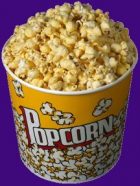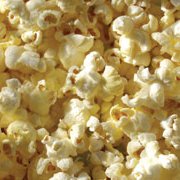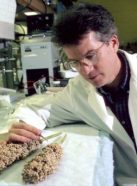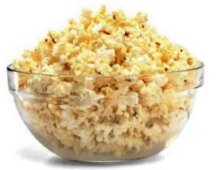Popping to Perfection
Scientists have uncovered why some popcorn kernels stay unpopped in the microwave.
Share this:
- Share via email (Opens in new window) Email
- Click to share on Facebook (Opens in new window) Facebook
- Click to share on X (Opens in new window) X
- Click to share on Pinterest (Opens in new window) Pinterest
- Click to share on Reddit (Opens in new window) Reddit
- Share to Google Classroom (Opens in new window) Google Classroom
- Click to print (Opens in new window) Print
By Emily Sohn
You’re at the movies. The feature’s starting. You’ve got a soda in one hand and a bucket of popcorn in the other. Just as the opening scene begins to suck you in, you crunch down on a mouthful of popcorn, and . . . ouch! You’ve bitten into a hard, unpopped kernel.
“It’s bothersome,” says Bruce Hamaker. He’s a food chemist at Purdue University in West Lafayette, Indiana. “It can chip teeth if people aren’t paying attention.”
 |
| Artville |
Instead of just grumbling about the problem, Hamaker and his coworkers have used science to try to figure out a way to reduce the number of unpopped kernels at the bottom of a bag of microwave popcorn.
The results may do more than just do away with the annoyance of biting into rock-hard kernels in the middle of a movie. Popcorn is an important crop in Indiana, Nebraska, and other states. Growing types of popcorn that pop better than current varieties do could improve popcorn sales.
Pressure cooker
Not just any type of corn will pop. Popcorn kernels are rounded and hard on the outside. They contain moisture on the inside. For a kernel to pop properly, water must make up between 14.5 and 15 percent of a kernel’s weight
Each kernel of popcorn is like a pressure cooker waiting to blow. As a kernel heats up in a microwave, pot, or air popper, water naturally found inside heats up, turns to gas, and expands. The pressure builds up inside the heated kernel until its shell bursts.
These little explosions turn kernels inside out, leaving behind airy balls of fluff that somehow make movies more special.
Depending on the variety of popcorn, kernels pop to form one of two shapes. The “butterfly” type, which is most common, is big and fluffy and looks as if it has wings. The “mushroom” type is round and compact. It’s better at holding cheese, caramel, and other coatings without falling apart.
 |
|
The “butterfly” type of popcorn is big and fluffy. |
Fatty coatings
To tackle the unpoppable popcorn problem, Hamaker and his coworkers started with a hunch.
Previous research had suggested that certain kernels lose moisture too quickly, either when stored or when heated. Without the proper amount of steam inside, the kernels would then fail to pop.
So, the researchers began by looking for coatings that would prevent moisture loss. Pretty soon, they found that coating kernels with certain types of fat could practically eliminate unpopped kernels.
Coating kernels before popping them isn’t an ideal solution, however. Extra fat could make popcorn greasy. And adding coatings would create more work for popcorn processing companies.
“They’d rather not add something to the process,” Hamaker says.
Crystal hull
Instead, the scientists decided that it might help to understand why some kernels lose moisture faster than others do in the first place.
 |
|
Food chemist Bruce Hamaker has studied a variety of foods. Here, he’s examining samples of sorghum. |
| Purdue University |
So, they studied 14 varieties of popcorn that had different microwave popping qualities. When the worst varieties were heated, as many as 47 percent of the kernels didn’t pop. The best varieties had only a 4 percent failure rate.
The secret, it turns out, lies in the structure of a kernel’s outer hull, also called the pericarp.
One-third of a popcorn kernel’s hull is made up of a material called cellulose. Found in all plant cells, cellulose is a kind of carbohydrate—a compound made up of carbon, hydrogen, and oxygen.
When heated, the cellulose in a kernel’s pericarp rearranges itself into an orderly structure known as a crystal. “It’s interesting that cellulose would undergo this kind of transition,” Hamaker says.
The crystalline sheet is tighter than the original cellulose, which is only partially ordered. “It forms a better barrier,” he says, “and keeps moisture in the kernel better.”
Why some popcorn kernels are better poppers than others depends on how orderly these crystalline sheets are, the researchers found. The best poppers have cellulose that’s especially good at turning into crystals.
Better coatings
This popcorn research could prove useful to popcorn growers. One good strategy would be to breed corn that produces kernels with pericarps made of a type of cellulose that turns into nice crystals.
 |
| NASA |
The chemical processes involved in popcorn popping could also end up being of interest in other fields of food science, Hamaker says. Perhaps scientists could come up with cellulose coatings that would keep moisture inside fruits or grains and keep them fresher longer.
Hamaker had never studied popcorn before. After endless batches of popcorn, popped and eaten in his lab, he was surprised at how much there is to learn about something as seemingly simple as popcorn.
“Everything’s more complicated than you think,” Hamaker says. “The interesting thing about science to me is when you learn something unexpected that gives you an answer to a problem you’re working on.”
Going Deeper:
Science Project Brainstorms
Are you interested in investigating popcorn? Here are some questions that may be worth tackling.
- How does the type of coating (fat) affect the number of unpopped popcorn kernels?
- Do different brands of popcorn leave different amounts of unpopped kernels?
For other science project ideas, go to www.popweaver.com/popcorn101/science/
science_list.html
(Weaver Popcorn Company) or www.exploringminds.ca/e/featuring_science_fair/qp_pop_corn.html
(Exploring Minds).






